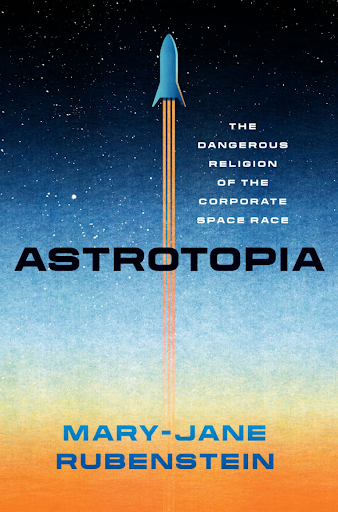
September 12, 2024
Q&A: Mary-Jane Rubenstein Explores the Cosmos and the Divine in New Book Astrotopia
Dr. Mary-Jane Rubenstein is a Professor of Religion and Science and Technology Studies at Wesleyan University. Her recent book, Astrotopia: The Dangerous Religion of the Corporate Space Race, draws parallels between religious history and the new frontier of space exploration led by tech entrepreneurs such as Elon Musk and Jeff Bezos. Dr. Rubenstein holds a B.A. from Williams College, an M.Phil. from The University of Cambridge, and a Ph.D. from Columbia University. (This interview has been lightly edited for clarity.)
Data Catalyst Institute: Your new book Astrotopia examines how current Earth-side problems are motivating renewed excitement for space exploration. How can space exploration benefit humankind?

Mary-Jane Rubenstein: The space industry’s most obvious earthly benefit is technology. As I write this response, I am relaying my words to you via satellite technology; many of our readers will rely on satellites when they load this site. Our mobile phones, GPS devices, fitness watches, security systems, and even some of our kitchen appliances are now totally reliant on machines we’ve rocketed into orbit.
Satellites also help us predict the weather more effectively than ever before, allowing communities to prepare for increasing hurricanes, tornadoes, and floods. They allow scientists to map global climate change, crop loss, lakefront recession, and coastal erosion. Scientists working on the International Space Station (ISS) have harnessed microgravity to advance biomedical research, improve construction materials, and discover better ways of managing energy.
Farther off Earth than these satellites, our missions to the Moon, Venus, and Mars have deepened our understanding of the nature and history of our solar system. Eventually, we may find microbes on another planet that improve or even transform our understanding of what “life” is.
Finally, space exploration offers the possibility of finding a home for human beings beyond our earthly cradle. I want to examine this promise–human salvation in outer space—as carefully as possible so we don’t use it as an excuse to give up on the Earth.
DCI: Astrotopia discusses the emergence of government partnerships with tech billionaires like Jeff Bezos and Elon Musk as they become major players in the New Space Race. How can tech entrepreneurs and the government collaborate effectively and humanely to drive innovation and achieve shared goals?
MJR: I love this question. The first task would be for governmental and private interests to clarify and align those goals with the common good. This means finding a reliable mechanism for communities to help shape our priorities in space.
The industry’s goals fall into four major categories: military, economic, scientific, and humanitarian. Frankly, most of the impetus for space exploration comes from the first two: rival nations are seeking strategic positions in orbit and on the Moon; developing nations are buying up orbits and testing anti-satellite weapons; and if there’s going to be a lunar or asteroidal gold rush, no one wants to be left behind. But the second two types of goals (scientific and humanitarian) show up on websites and public statements. The governmental space agencies say we’re exploring space to learn about the universe, while the CEOs talk about fulfilling our human destiny and creating a backup civilization to survive a cataclysm on Earth.
The path toward a humane pursuit of these goals lies in transparency and collaboration. If the real goal is to stimulate a new economy in space, then the industry should say that. They should explain that this means strip-mining the Moon, turning it into a “cosmic gas station,” and redirecting asteroids–and then see how the humans of Earth respond. Of course, transparency and collaboration tend to slow down technological progress and financial returns. But it is disingenuous to hide military and economic pursuits behind loftier, indisputable goals like saving the whole human species.
DCI: How do you view sustainably driven space initiatives like the public-private partnerships between the European Space Agency’s Zero Debris Charter (ZDC)? What can the U.S. space industry adopt from these types of partnerships?
MJR: It’s a very promising development and an example of public-private partnerships’ productive, communally-minded possibilities. Of course, we still lack the technology to remove orbital debris, so such an agreement would need to produce significant incentives for corporations to put their research and development into cleaning up the spaceways. That means directing energies away from other, more immediately lucrative efforts, so this effort will be a challenge given the current priority of financial profit in space.
I would like this recent turn to “space ecology” to include Earth’s atmosphere, stratosphere, wetlands, and waterways, which the industry is polluting at just as alarming a rate as the orbital pathways.
DCI: How can space exploration serve as a platform for enhancing international diplomacy, and what role should global cooperation play in the future of space missions?
MJR: I wonder about the relationship between multilateral agreements like the ZDC and United Nations productions like the “Space Debris Mitigation Guidelines.” Ideally, such agreements would extend to Europe and its partners and to all the spacefaring nations and corporations. When it comes to the US, I would like to see NASA refrain from producing an equivalent and recommit itself instead to the Committee on the Peaceful Uses of Outer Space. Space debris is such a universal problem that it’s possible the Committee could find agreement between the US, Russia, and China on this matter–and any diplomatic developments in that direction would be beneficial to us all. While we’re on the topic, I’d like to see the US rescind the “Wolf Amendment” that prohibits all cooperation between NASA and the China National Space Administration. If we can figure out how to build a space station that orbits the Moon, we can figure out how to talk to China.
DCI: Theoretically, if humans occupy Mars, how do you envision the space economy unfolding, and how does that compare to your ideal vision?
MJR: You’ve probably heard that there are two astronauts stranded on the ISS until February of next year. There are problems with the ship they rode in on, so they’ll need to find a different way home–and that different way home won’t come through until five months from now.
This is the time it will take to address the problems caused by routine spacecraft failures 250 miles from Earth. Imagine the difficulty of rescuing human beings stranded 140 million miles away on Mars.
All of this is to say I am nowhere near able to imagine what an economy on Mars would look like. As the industry repeats with knowing rolls of the eye, “space is hard.” And it’s going to be excruciatingly hard on Mars for the foreseeable future. Even if we can send human beings there within the next few decades, no one will be making money on the venture for centuries. And I’m not sure that’s a bad thing. If we ever figure out how to live on Mars, the extreme difficulty of sustaining ourselves there might require our rediscovering a more collaborative, reciprocal form of exchange than the market economy.

DCI: Finally, Astrotopia is a non-fiction study of the philosophy, science, innovation, history, and religion of humans and Space. When it comes to fiction, what work in this area inspires or entertains you most and why?
MJR: When it comes to outer space, I’m most excited by works of fiction that imagine just, equitable, and sustainable ways of living in new communities. The Terraformers by Annalee Newitz details the difficult job of bringing a planet into ecological balance and flourishing. Becky Chambers’ To Be Taught, If Fortunate traces the progress of a small crew of people who like and even love each other, transforming themselves to fit the exoplanets they visit rather than the other way around. N.K. Jemisin’s “The Ones Who Stay and Fight” imagines an extraterrestrial city where every human being actually matters. In Nanobah Becker’s The 6th World, a failing mission to Mars is saved when its Navajo astronaut discovers and cultivates a single ear of ancestral corn.
Especially when it comes to space, technology pushes the bounds of reality, making the unimaginable possible and even ordinary. Speculative and science fiction do the same thing–not only in relation to technology but also in relation to the societies that produce and sustain such technologies. While we’re going about the business of making the impossible possible, fiction can encourage us to imagine totally different ways of living in relation to one another and the land that sustains us.
For a PDF version of this Q&A, please see here.

